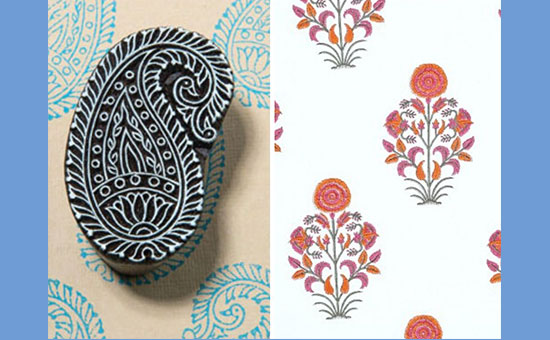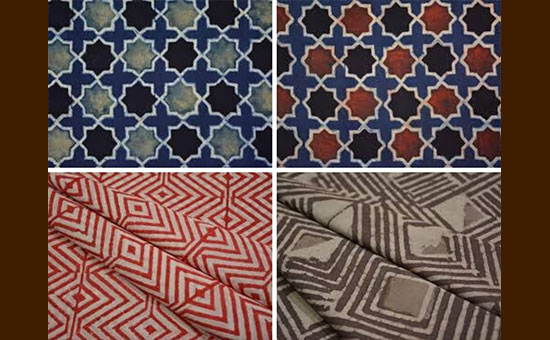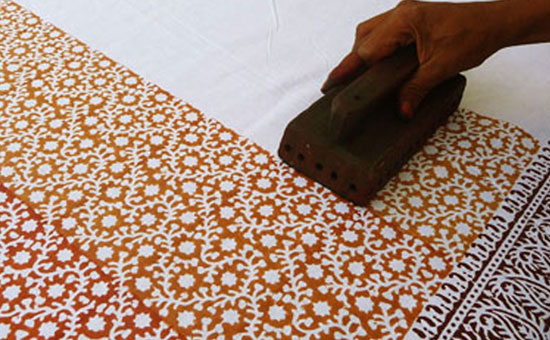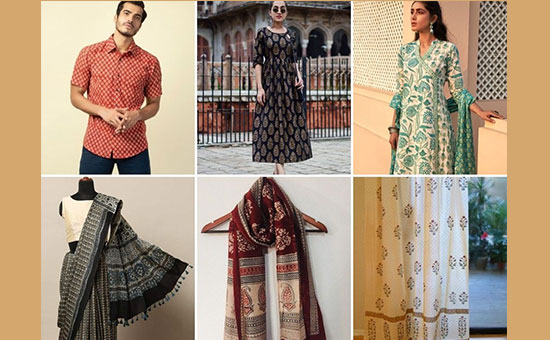-
Article explores Indian hand block
printing traditions.
India is a hub of cotton hand-block prints. Almost every state across Northern India has its own hand block printing tradition that has been preserved by several generations of prolific craftsmen. Just to quote a few examples – Gujarat has Ajrakh, Madhya Pradesh has Bagh and Rajasthan has Bagru, Dabu & Sanganeri block printing traditions.
So let us explore more about Indian hand block
printing traditions through this article.
Origin
& history
The recorded history of block printing dates
back to the Indus valley civilization i.e. around 3500 to 1300 BC.
There are many archaeological evidences
that prove that the Harappans were familiar with an early form of block
printing. Block print cotton fragments of this era have been found at different
excavation sites in India. Various types of needles, spindles and pieces of
printed cotton fibres have been excavated from excavation sites of Harappa,
Mohenjo Daro and Lothal etc. This gives further boost to the claim that the
Harappan artists were familiar with the block printing.
In the early 12th century, several cities
on southern, western and eastern coasts of India became trade centres for high
quality printed cotton clothes.
Wooden block printing and dyeing of
cottons became very common in various parts of Rajasthan and Gujarat as well. In
fact, Rajasthan and Gujarat became gigantic economic hubs for trading of
block-printed items. The wooden blocks were mostly used for printing fabrics
for royal costumes, floor coverings, bed sheets and decorative wall hangings.
Design
& Evolution
Some scholars point-out that block
printing reached its zenith under the Mughal rule in India. It also evolved in
terms of designs. For example, abstract & geometric designs that were used
in pre-Mughal era, were replaced largely by floral motifs like plants, tree of
life, kairi, vines, fruits, vegetables etc. Apart from floral motifs, paisley
motifs in block printing also gained prominence during the Mughal era.
Animal figures also found a place in the
design directory of block prints. Some common animal designs were peacock,
parrot, elephant, swan etc.
 Floral & Paisley motifs popularized during Mughal era.
Floral & Paisley motifs popularized during Mughal era.
Image source – willowandthatch.com and indigenoushandicrafts.com.
The major difference between the designs
of pre and post Mughal era was that the Mughal era designs were way curvier,
while pre-Mughal era designs were geometric. Meaning the designs leaned heavily
on squares, rectangles, triangles and other geometric shapes. The designs that
we see now are a mix of geometric and floral motifs.
 Abstract & Geometric motifs
Abstract & Geometric motifs
Image source – navyafashions.com.
Handblock printing process – An Overview
The block printing process varies slightly across different crafts. However, majority of steps are common. Firstly, wooden blocks are cut and the desired design is carved upon them. These wooden blocks have a handle attached to them – to dip the block in colour, lift & print them on the cloth. Once the blocks are carved, they are soaked in oil for a good 10-15 days to soften the wood.
The fabrics to be printed are first washed
to get rid of the starch, dried in the sun, and then laid down on a large table
- fastened using pins. Colours are prepared in separate trays using glue &
pigment binder. The block is then dipped in the tray full of colours, and
slammed hard on the fabric with fist. The design goes from outward to inward
i.e. the outline is printed first with black or dark colour and then filled in
using different colours.
Once the printing is complete, the fabric
is dried in the sun, then washed again (with acid & water) and dried again.
That is how the colour is established.
The process of block printing is totally
manual, incredibly difficult and therefore requires precision, artistry of the
greatest degree.
 credits–handblockprint.com
credits–handblockprint.com
Current
state of the craft
By the early 18th century, the beautiful
art of block printing started fading away largely due to the heavy taxes were
imposed on Indian textiles during the British rule. Consequently, many
hand block printers from rural India gave up this craft and migrated to the
cities to work in cotton mills.
 Various products from block printing traditions. Source pinterest.com
Various products from block printing traditions. Source pinterest.com
However, since independence, the government
has launched a number of schemes to support the craft and craftspeople, some of
them directly aimed towards block-printing craft. Educational institutions like
National Institute of Design (NID) & National Institute of Fashion
Technology (NIFT) have helped in spreading awareness about crafts by enabling
students to collaborate with craftspeople on projects related to design,
marketing & promotion.
Over the years, numerous gigantic design
houses as well as small designers within the industry have also worked with the
craft to create contemporary silhouettes, making it more relatable. Due to all
these efforts, the craft has definitely seen resurgence in modern times.
To read all
articles by author
Also see pictures of
1. Block
printing Sanganer near Jaipur
2. Village
Kutch where block printing is done pics 10 to 14